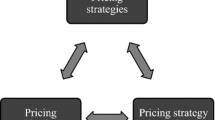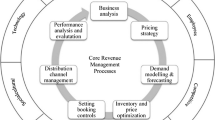Abstract
Emerging price optimization models systematically incorporate competitor price information into the derivation of optimal price points. While consideration of competitor pricing at this tactical level is essential to maximizing short-term revenues, the long-term impact of competitive price positioning on revenue performance should not be overlooked. This study examines the effect of two key dimensions of strategic price positioning – relative price position and relative price fluctuation – on the revenue performance of 6998 US hotels over an 11-year period. It finds that revenue performance is strongest for hotels that price higher than the competition and maintain a consistent relative price over time. Implications for revenue management practitioners are discussed.
Similar content being viewed by others
Notes
Rather than examine technical efficiency in terms of physical inputs and outputs as in previous studies (for example, Alam and Sickles, 2000), Alam et al (2001) looked at oligopolistic pricing behavior as measured by means and distributions of sustained non-marginal cost pricing policies.
Transaction utility is the perceived value associated with getting a good deal.
STR's location segments are defined as follows: Urban: A densely populated area in a large metropolitan area (for example, Atlanta, Boston); Suburban: Suburbs of metropolitan markets (for example, Sags Harbor and White Plains, New York, near New York City); Airport: Hotels in close proximity of an airport that primarily serve demand from airport traffic; Interstate/motorway: Hotels in close proximity of major highways, motorways or other major roads whose primary source of business is through passerby travel; Resort: Any hotel located in a resort area or market where a significant source of business is derived from leisure/destination travel (for example, Orlando, Lake Tahoe, Daytona Beach); Small Metro/Town: Areas with either smaller population or limited services, in remote locations, populated with less than 150 000 people.
STR defines five categories within metro markets – Luxury: top 15 per cent average room rates; Upscale: next 15 per cent average room rates; Midscale: middle 30 per cent average room rates; Economy: next 20 per cent average room rates; Budget: lowest 20 per cent average room rates. In rural or non-metro STR markets, the luxury and upscale segments are collapsed into a single upscale segment to form four price segment categories – Upscale: top 30 per cent average room rates; Midscale: next 30 per cent average room rates; Economy: next 20 per cent average room rates; Budget: lowest 20 per cent average room rates.
Additional analysis can be obtained by contacting the authors.
References
Aaker, D. (1996) Building Strong Brands. New York: The Free Press.
Ailawadi, K., Lehmann, D. and Neslin, S. (2001) Market response to a major policy change in the marketing mix: Learning from Procter & Gamble's value pricing strategy. Journal of Marketing 65 (1): 44–61.
Alam, I.S. and Sickles, R.C. (2000) Time series analysis of deregulatory dynamics and technical efficiency: The case of the U.S. airline industry. International Economic Review 41 (1): 203–218.
Alam, I.M.S., Ross, L.B. and Sickles, R.B. (2001) Time series analysis of strategic behavior in the U.S. airline industry. Journal of Productivity Analysis 16 (1): 49–62.
Anderson, C.K. and Wilson, J.G. (2003) Wait or buy? The strategic consumer: Pricing and profit implications. Journal of the Operational Research Society 54 (3): 299–306.
Bolton, R. and Shankar, V. (2003) An empirically derived taxonomy of retailer pricing and promotion strategies. Journal of Retailing 79 (4): 213–224.
Chung, K. (2000) Hotel room rate pricing strategy for market share in oligopolistic competition – Eight-year longitudinal study of super deluxe hotels in Seoul. Tourism Management 21 (2): 135–145.
Cross, R., Higbie, J. and Cross, D. (2009) Revenue management's renaissance. Cornell Hospitality Quarterly 50 (1): 56–81.
Enz, C. A. and Canina, L. (2010) Competitive pricing in European hotels. In: J.S. Chen (ed.) Advances in Hospitality and Leisure (6), Emerald Group Publishing, pp. 3–25.
Enz, C., Canina, L. and Lomanno, M. (2004) Why discounting doesn’t work: The dynamics of rising occupancy and falling revenue among competitors. Center for Hospitality Research Report 4 (7): 6–25.
Enz, C., Canina, L. and Lomanno, M. (2009) Competitive pricing decisions in uncertain times. Cornell Hospitality Quarterly 50 (3): 325–341.
Erdem, T. and Swait, J. (1998) Brand equity as a signaling phenomenon. Journal of Consumer Psychology 7 (2): 131–157.
Gallego, G. and Hu, M. (2007) Dynamic Pricing of Perishable Assets under Competition. New York: USA, Columbia University Working Paper.
Hanssens, D. (1980) Market response, competitive behavior, and time series analysis. Journal of Marketing Research 17 (4): 470–485.
Hawtin, M. (2003) The practicalities and benefits of applying revenue management to grocery retailing, and the need for effective business rule management. Journal of Revenue and Pricing Management 2 (1): 61–68.
Krishna, A. (1994) The impact of dealing patterns on purchase behavior. Marketing Science 13 (4): 351–373.
Lambin, J., Naert, P. and Bultez, A. (1975) Optimal marketing behavior in oligopoly. European Economic Review 6 (2): 105–128.
Levin, Y., McGill, J. and Nediak, M. (2009) Dynamic pricing in the presence of strategic consumers and oligopolistic competition. Management Science 55 (1): 32–46.
Lieberman, W. (2004) Revenue management trends and opportunities. Journal of Revenue and Pricing Management 3 (1): 91–99.
Mela, C., Gupta, S. and Lehmann, D. (1997) The long-term impact of promotion and advertising on consumer brand choice. Journal of Marketing Research 34 (2): 248–261.
Mookherjee, R. and Friesz, T. (2008) Pricing, allocation, and overbooking in dynamic service network competition when demand is uncertain. Production and Operations Management 17 (4): 455–474.
Perakis, G. and Sood, A. (2006) Competitive multi-period pricing for perishable products: A robust optimization approach. Mathematical Programming 107 (1): 295–335.
Shankar, V. and Bolton, R. (2004) An empirical analysis of determinants of retailer pricing strategy. Marketing Science 23 (1): 28–49.
Swait, J. and Erdem, T. (2002) The effects of temporal consistency of sales promotions and availability on consumer choice behavior. Journal of Marketing Research 39 (3): 304–320.
Talluri, K. and Van Ryzin, G. (2004) The Theory and Practice of Revenue Management. New York: Springer.
Thaler, R. (1985) Mental accounting and consumer choice. Marketing Science 4 (3): 199–214.
Author information
Authors and Affiliations
Rights and permissions
About this article
Cite this article
Noone, B., Canina, L. & Enz, C. Strategic price positioning for revenue management: The effects of relative price position and fluctuation on performance. J Revenue Pricing Manag 12, 207–220 (2013). https://doi.org/10.1057/rpm.2012.48
Received:
Revised:
Published:
Issue Date:
DOI: https://doi.org/10.1057/rpm.2012.48




